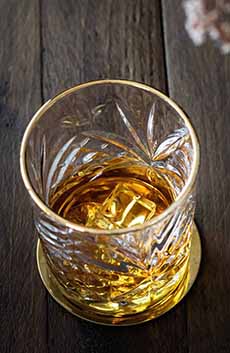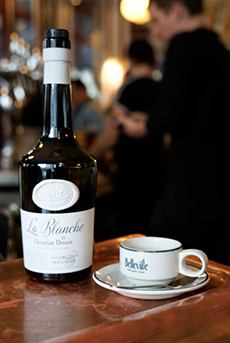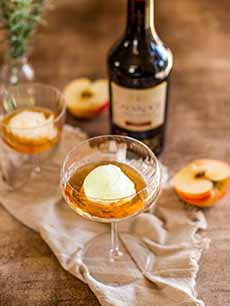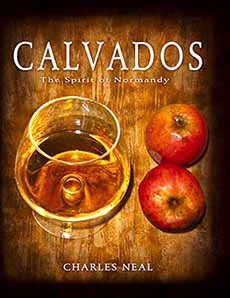Calvados, The Finest Apple Brandy From France
|
From the orchards of Normandy, France comes Calvados, at its simplest an apple brandy. But it is the best apple brandy (or more precisely eau-de-vie*) in the world. Once fermented, apple juice becomes cider, and, once distilled, the cider becomes a cider eau-de-vie. The cider that begins thew process is pressed from specially grown cider apples, sometimes with cider pears added (see Calvados Domfrontais, below). The apples range from bitter to tart to sweet. They are different from eating apples and are grown specifically for cider. Calvados is one of the three brandies produced in the Calvados département of Normandy. Calvados is produced from apples while the other two, Armagnac and Cognac are produced from grapes. Today, there are three controlled appellations: After two or three years of aging in oak casks, it can be sold as Calvados. Like other types of brandy, the longer it is aged in casks, the smoother the spirit becomes. > October is World Calvados Day. > The history of Calvados is below. > For a fall cocktail or mocktail, check out this recipe. > You can also add Calvados to sangria. Check out this recipe. > If you like your beverages to sparkle, here’s a recipe for Sparkling Apple Cider Sangria with Calvados. First, to drink: Calvados is great over ice as an apéritif and can be found in numerous cocktail recipes. It is a popular ingredient in hot toddies. As a palate cleanser (to awaken the palate) between fish and meat courses, a small liqueur glass of Calvados with a small scoop of sorbet hits the spot. For those who want more than one palate cleanser, consider le trou Normand (the Norman hole), a small drink of Calvados taken between courses of a multicourse meal, sometimes with apple or pear sorbet. As an after-dinner drink, a snifter of Calvados is as welcome as any fine brandy or Cognac. Calvados can also be enjoyed throughout an entire meal when a few small sips will delight the palate and bring out the flavor of many dishes. You can sip Calvados with: Crowd favorites include anything chocolate, Tarte Tatin and other fruit tarts, and tiramisu. While apple orchards and brewers date to centuries B.C.E., apple orchards and brewers of apple cider are mentioned as far back as the 8th century by Charlemagne himself. The mild climate of Normandy led to the planting of more apple trees there than anywhere else in France [source]. Before water safety measures in modern times, many people drank beer or hard cider, the production of which killed off harmful bacteria. The 12th through 18th centuries. The Arabs, who invented distillation, had introduced Europeans to it in the 12th century. The first known record of distillation in Britain appears in 1553, and the guild for cider distillation was created about 50 years later in 1606. Until the 17th century, the distillation of cider was used solely for local and personal consumption. In the 17th century, the reputation of distilled cider began to grow [source]. Calvados is one of the original 83 departments of France created during the French Revolution in 1790, named after a group of rocks off its coast**. Today it is incorporated into the region of Normandy. But before then, the eau de vie de cidre was already made and called Calvados in common usage. The 19th century. In the 19th century, production grew thanks to distillation technology during the Industrial Revolution. The 1860s saw the creation of the first industrial distillery [source]. At the same time, the fashion for Café-Calva† grew among the working class (photo #3). Today many people have re-adopted the tradition. Starting around 1860, a tiny yellow aphid called phylloxera began to decimate Europe’s vineyards. France is considered to have been worst affected [source]. As the vineyards of France were devastated, Calvados, experienced a golden age. Orchards were not affected by phylloxera. The 20th century. During World War I (1914-1918), cider brandy was requisitioned to make explosives for the armament industry due to its high alcohol content. After the war, many cider houses and distilleries were reconstructed and gave rise to the thriving industry of today [source]. Prohibition (1920-1933) led to a rise in the popularity of cocktail drinking, and Calvados was one of the most popular ingredients for many cocktails. Ernest Hemingway helped make the Jack Rose famous in “The Sun Also Also Rises” [source]. The recipe is in the footnote*** below. |
|
|
|
World War II (1939-1945) was a chaotic period for Calvados production. The need for alcohol for the production of explosives led to the authorities monopolizing all available alcohol resources except for those that had been granted designation of origin status prior to the start of the global conflict. Calvados almost ceased to exist as a result, swallowed up by the alcohol quotas required for the war effort. A 1942 decree established the Appellations d’Origine Réglementée (A.O.R) for apple and pear cider eau-de-vies from several regions in Normandy, and these became exempt from the requisition. There were 10 of these AORs in total: Calvados du Calvados, Calvados du Domfrontais, Calvados du Perche, Calvados du Merlerault, Calvados du Cotentin, Calvados de l’Avranchin, Calvados du Pays de la Risle, Calvados du Pays de Bray, Calvados du Mortainais, Calvados du Pays du Merlerault. This recognition marked the start of a new era for Calvados. Producers were obliged to adhere to a strict set of specifications, tightly-regulated production methods, and specific terminology with which to label their products. In 1984, the 10 official AORs were grouped together under the “Calvados” appellation. Today, all the Calvados distilleries are organized within the IDAC (Interprofessional Association of Cider-Based Controlled Appellations). There are also cider works engaged in the production of Pommeau de Normandie and AOP/PDO ciders and perries…but that’s for another article. *Eau-de-vie (“water of life”) is the French term for brandies made from a fruit other than grapes. **More precisely, Calvados was derived from calva dorsa, meaning bare backs, which referred to two sparsely vegetated rocks off its shore. ***Jack Rose Cocktail Recipe: Per drink, combine 2 ounces of Calvados, applejack, or apple brandy with one ounce of lemon or lime juice and 1/2 ounce of Chambord (substitute crème de cassis or other blackcurrant liqueur). Shake all the ingredients with ice and strain into a stemmed cocktail glass. Garnish with a lemon twist. †Café-Calva is the practice of pouring a little Calvados into one’s cup of coffee. It has enjoyed immense popularity in farms and bistros of Normandy since the 1880s. ‡Why is it called a hole? According to La Confrérie du Trou Normand, it references its alleged therapeutic qualities. As the Calvados graces the palate, its fruity and invigorating qualities cleanse and awaken the taste buds, preparing them for the next dish [source]. Why is this a “hole?” We believe that something is lost in translation! ‡‡Perry is cider made from pears. ‡‡‡Brandy: Although most often derived from grapes brandy can be made from apples, apricots, peaches, and other fruits. While brandy can be made anywhere in the world, particular regional styles are the best-known: Armagnac, Calvados, Cognac, grappa, and pisco.
|
||





